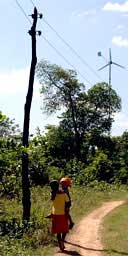
Green power to Gurugoda
When darkness fell on the quiet hamlet of Gurugoda in Sri Lanka's north-western province, Anoma Kumari's home would become a den of danger. Would her teenage daughter complete her homework without going up in flames? Would her family of five finish their dinner without a gust of wind igniting the house's bamboo rafters? The causes of Anoma's anxiety were small bottles of kerosene slotted into rusty tin cans that dimly lit her home. She resorted to such risky methods because her family is among the 25% of Sri Lanka's 20 million people whose homes are not connected to the national grid. Access to electricity varies hugely between urban areas and remote rural villages. In the capital, Colombo, more than 95% of households have electricity; in the district where Anoma's family lives just 40% of homes are connected. The families living in the 12 mud-floored homes of Gurugoda are said to be at least five years away from the grid's reach. Until recently they spent up to a quarter of their small incomes on kerosene. "My husband doesn't get regular work and with three children, there were times when we couldn't afford whole bottles," Anoma said. "So we'd cut back on food just to buy a quarter of a bottle so my daughter could keep up with her studies." But three months ago, a solution arrived in the form of a wind turbine. Wires strung across poles made from branches of local trees greet visitors travelling down the mud track to the hamlet. High above, the turbine blades turn through the clear sky. Anoma's 16-year-old daughter Gayani now not only revises for her O-levels in safety, she also turns on the family's old black and white television to watch programmes that go over Singhalese, science and maths papers. Money that would have been used to buy kerosene can be spent on food and schoolbooks. With a new light bulb the family also managed to spot three poisonous snakes. The turbine, which provides each household with 200W of electricity from dusk to dawn, was specially developed for the village by Practical Action, which worked with local authorities and a community organisation to ensure that the technology and the amount of energy consumed were right for the weather and social conditions of Gurugoda. None of the homes is metered and villagers are not charged for
electricity. Instead they rely on the close networks of rural Sri
Lankan life to ensure that the small supply of energy is distributed
equally. The turbine project is part of Practical Action's ambition to transform Gurugoda into a "green hamlet" by introducing sustainable energy. "Energy is a basic requirement for development," says Namiz Musafer, project manager for Practical Action. In the village of Rajasaranagama, nestled in the interior of southern Sri Lanka, Hilda Ranjani has greatly boosted her earnings by changing her energy supply. For years, the 38-year-old farmer's wife had spent one week in every month collecting firewood, her only source of cooking fuel for a family of five. The smoke stung her eyes and left her gasping. She developed asthma 10 years ago and was increasingly unable to tolerate the fumes, which meant her teenage daughter was called away from her schoolwork to take over. Today her mud-walled kitchen is smoke-free. A plastic tube snakes from a gas stove to the back garden where it connects to a sunken tank storing gas made by fermenting water with manure from the Ranjanis' cows. Installed and managed by Practical Action, the family's "digester" is among 60 biogas schemes it has introduced in Sri Lanka. Each produces enough gas to cook for 10 people. Once the gas is removed, the residue is quality organic fertiliser. With the quarter of her time she once spent collecting wood, Ms Ranjani now makes and sells incense sticks, bringing in 2,500 rupees (£12) a month, enough to send her three children to the tuition classes needed to pass school exams in Sri Lanka. "I need to educate my children as much as I possibly can. It's what they want," she said. Courtesy The Guardian, UK |
|| Front
Page | News | Editorial | Columns | Sports | Plus | Financial
Times | International | Mirror | TV
Times | Funday
Times || |
| |
Copyright
2006 Wijeya
Newspapers Ltd.Colombo. Sri Lanka. |
